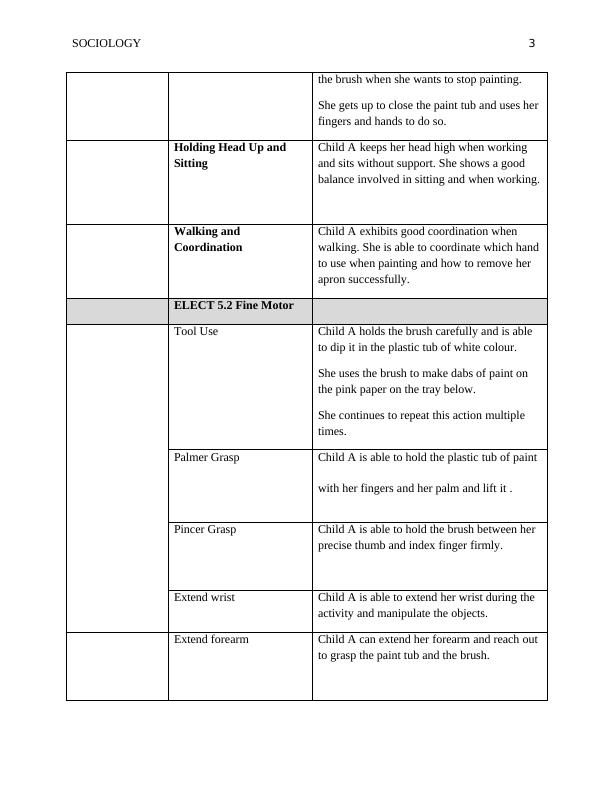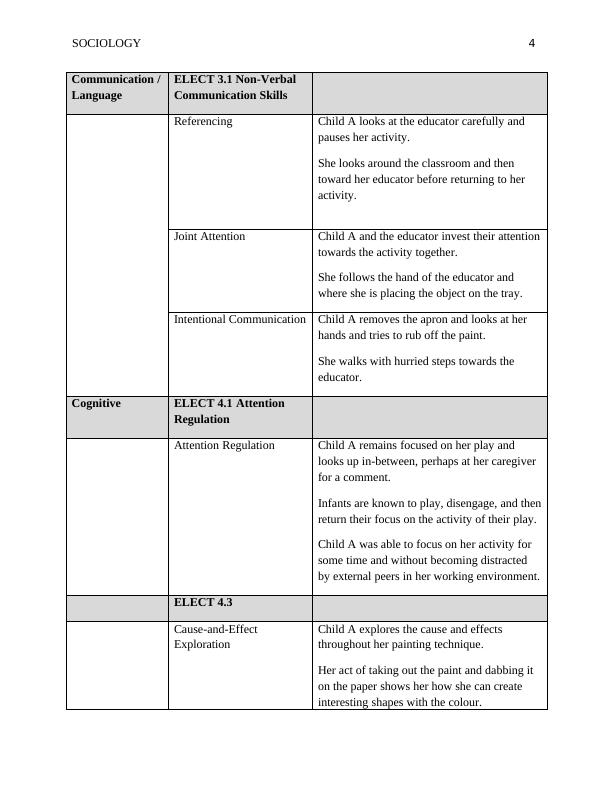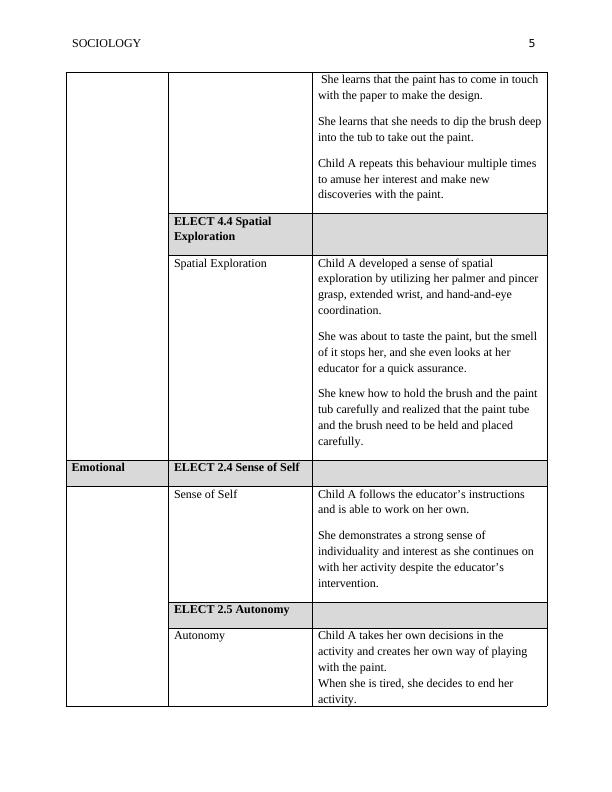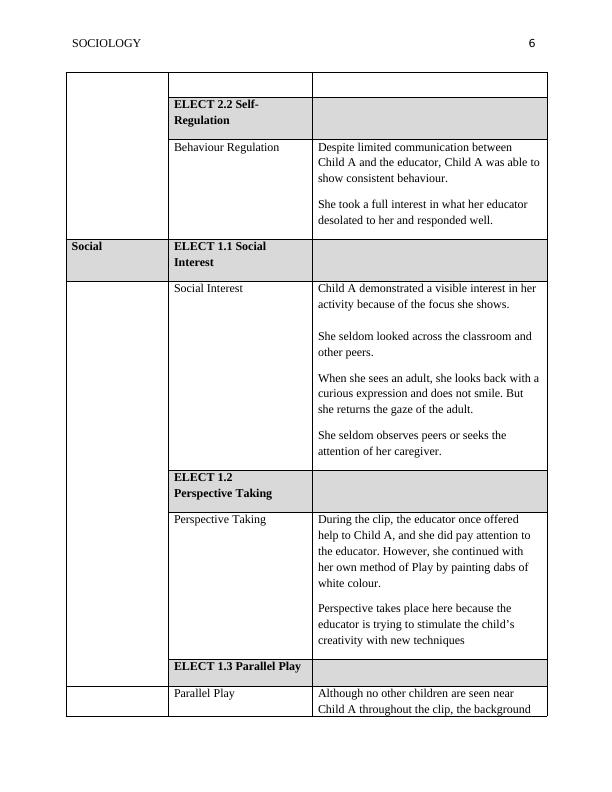Early Childhood Education and Care Methods
Added on 2022-09-07
24 Pages6552 Words22 Views
Running Head: SOCIOLOGY 1
Early Childhood Education and Care
Name of University
Early Childhood Education and Care
Name of University

SOCIOLOGY 2
Introduction
When making an observation of children and documenting their activities in early
childhood settings, it is essential to make a pedagogically sound observation and document
meaningful learning experiences. According to Fenning. & Wylie (2015), it is essential to
develop transformative ways of education and learning through observation of young children,
toddlers, and infants. The paper aims to make use of a variety of observational tools and identify
transformative practices with reflections to follow the best for thee for observing.
Three video clips are selected, and two clips are of infants age group and one clip from
the toddler age-range. The actions and behaviors of the infants and toddlers within each selected
clip are observed. The responses and behaviors of the adults are observed, and all the
observations are documented to identify the developmental areas of the child and what specific
skills they carry or need to improve on.
ECE 114 Child Development: Pre-natal to 2 ½ Years
Research Assignment Charts
Infant
InfantName of First Video: Video 1.3a What is my Image of the Child
Column A Column B Column C
Developmental
Area
SKILL EVIDENCE from Child Observed
Physical ELECT 5.1 Gross Motor
Reaching, Holding and
Releasing
Child A shows effective skills for reaching
out, holding to objects, and releasing them
with palmar grasp.
She is able to extend her arm and put the
paintbrush inside the paint tub and can release
Introduction
When making an observation of children and documenting their activities in early
childhood settings, it is essential to make a pedagogically sound observation and document
meaningful learning experiences. According to Fenning. & Wylie (2015), it is essential to
develop transformative ways of education and learning through observation of young children,
toddlers, and infants. The paper aims to make use of a variety of observational tools and identify
transformative practices with reflections to follow the best for thee for observing.
Three video clips are selected, and two clips are of infants age group and one clip from
the toddler age-range. The actions and behaviors of the infants and toddlers within each selected
clip are observed. The responses and behaviors of the adults are observed, and all the
observations are documented to identify the developmental areas of the child and what specific
skills they carry or need to improve on.
ECE 114 Child Development: Pre-natal to 2 ½ Years
Research Assignment Charts
Infant
InfantName of First Video: Video 1.3a What is my Image of the Child
Column A Column B Column C
Developmental
Area
SKILL EVIDENCE from Child Observed
Physical ELECT 5.1 Gross Motor
Reaching, Holding and
Releasing
Child A shows effective skills for reaching
out, holding to objects, and releasing them
with palmar grasp.
She is able to extend her arm and put the
paintbrush inside the paint tub and can release

SOCIOLOGY 3
the brush when she wants to stop painting.
She gets up to close the paint tub and uses her
fingers and hands to do so.
Holding Head Up and
Sitting
Child A keeps her head high when working
and sits without support. She shows a good
balance involved in sitting and when working.
Walking and
Coordination
Child A exhibits good coordination when
walking. She is able to coordinate which hand
to use when painting and how to remove her
apron successfully.
ELECT 5.2 Fine Motor
Tool Use Child A holds the brush carefully and is able
to dip it in the plastic tub of white colour.
She uses the brush to make dabs of paint on
the pink paper on the tray below.
She continues to repeat this action multiple
times.
Palmer Grasp Child A is able to hold the plastic tub of paint
with her fingers and her palm and lift it .
Pincer Grasp Child A is able to hold the brush between her
precise thumb and index finger firmly.
Extend wrist Child A is able to extend her wrist during the
activity and manipulate the objects.
Extend forearm Child A can extend her forearm and reach out
to grasp the paint tub and the brush.
the brush when she wants to stop painting.
She gets up to close the paint tub and uses her
fingers and hands to do so.
Holding Head Up and
Sitting
Child A keeps her head high when working
and sits without support. She shows a good
balance involved in sitting and when working.
Walking and
Coordination
Child A exhibits good coordination when
walking. She is able to coordinate which hand
to use when painting and how to remove her
apron successfully.
ELECT 5.2 Fine Motor
Tool Use Child A holds the brush carefully and is able
to dip it in the plastic tub of white colour.
She uses the brush to make dabs of paint on
the pink paper on the tray below.
She continues to repeat this action multiple
times.
Palmer Grasp Child A is able to hold the plastic tub of paint
with her fingers and her palm and lift it .
Pincer Grasp Child A is able to hold the brush between her
precise thumb and index finger firmly.
Extend wrist Child A is able to extend her wrist during the
activity and manipulate the objects.
Extend forearm Child A can extend her forearm and reach out
to grasp the paint tub and the brush.

SOCIOLOGY 4
Communication /
Language
ELECT 3.1 Non-Verbal
Communication Skills
Referencing Child A looks at the educator carefully and
pauses her activity.
She looks around the classroom and then
toward her educator before returning to her
activity.
Joint Attention Child A and the educator invest their attention
towards the activity together.
She follows the hand of the educator and
where she is placing the object on the tray.
Intentional Communication Child A removes the apron and looks at her
hands and tries to rub off the paint.
She walks with hurried steps towards the
educator.
Cognitive ELECT 4.1 Attention
Regulation
Attention Regulation Child A remains focused on her play and
looks up in-between, perhaps at her caregiver
for a comment.
Infants are known to play, disengage, and then
return their focus on the activity of their play.
Child A was able to focus on her activity for
some time and without becoming distracted
by external peers in her working environment.
ELECT 4.3
Cause-and-Effect
Exploration
Child A explores the cause and effects
throughout her painting technique.
Her act of taking out the paint and dabbing it
on the paper shows her how she can create
interesting shapes with the colour.
Communication /
Language
ELECT 3.1 Non-Verbal
Communication Skills
Referencing Child A looks at the educator carefully and
pauses her activity.
She looks around the classroom and then
toward her educator before returning to her
activity.
Joint Attention Child A and the educator invest their attention
towards the activity together.
She follows the hand of the educator and
where she is placing the object on the tray.
Intentional Communication Child A removes the apron and looks at her
hands and tries to rub off the paint.
She walks with hurried steps towards the
educator.
Cognitive ELECT 4.1 Attention
Regulation
Attention Regulation Child A remains focused on her play and
looks up in-between, perhaps at her caregiver
for a comment.
Infants are known to play, disengage, and then
return their focus on the activity of their play.
Child A was able to focus on her activity for
some time and without becoming distracted
by external peers in her working environment.
ELECT 4.3
Cause-and-Effect
Exploration
Child A explores the cause and effects
throughout her painting technique.
Her act of taking out the paint and dabbing it
on the paper shows her how she can create
interesting shapes with the colour.

SOCIOLOGY 5
She learns that the paint has to come in touch
with the paper to make the design.
She learns that she needs to dip the brush deep
into the tub to take out the paint.
Child A repeats this behaviour multiple times
to amuse her interest and make new
discoveries with the paint.
ELECT 4.4 Spatial
Exploration
Spatial Exploration Child A developed a sense of spatial
exploration by utilizing her palmer and pincer
grasp, extended wrist, and hand-and-eye
coordination.
She was about to taste the paint, but the smell
of it stops her, and she even looks at her
educator for a quick assurance.
She knew how to hold the brush and the paint
tub carefully and realized that the paint tube
and the brush need to be held and placed
carefully.
Emotional ELECT 2.4 Sense of Self
Sense of Self Child A follows the educator’s instructions
and is able to work on her own.
She demonstrates a strong sense of
individuality and interest as she continues on
with her activity despite the educator’s
intervention.
ELECT 2.5 Autonomy
Autonomy Child A takes her own decisions in the
activity and creates her own way of playing
with the paint.
When she is tired, she decides to end her
activity.
She learns that the paint has to come in touch
with the paper to make the design.
She learns that she needs to dip the brush deep
into the tub to take out the paint.
Child A repeats this behaviour multiple times
to amuse her interest and make new
discoveries with the paint.
ELECT 4.4 Spatial
Exploration
Spatial Exploration Child A developed a sense of spatial
exploration by utilizing her palmer and pincer
grasp, extended wrist, and hand-and-eye
coordination.
She was about to taste the paint, but the smell
of it stops her, and she even looks at her
educator for a quick assurance.
She knew how to hold the brush and the paint
tub carefully and realized that the paint tube
and the brush need to be held and placed
carefully.
Emotional ELECT 2.4 Sense of Self
Sense of Self Child A follows the educator’s instructions
and is able to work on her own.
She demonstrates a strong sense of
individuality and interest as she continues on
with her activity despite the educator’s
intervention.
ELECT 2.5 Autonomy
Autonomy Child A takes her own decisions in the
activity and creates her own way of playing
with the paint.
When she is tired, she decides to end her
activity.

SOCIOLOGY 6
ELECT 2.2 Self-
Regulation
Behaviour Regulation Despite limited communication between
Child A and the educator, Child A was able to
show consistent behaviour.
She took a full interest in what her educator
desolated to her and responded well.
Social ELECT 1.1 Social
Interest
Social Interest Child A demonstrated a visible interest in her
activity because of the focus she shows.
She seldom looked across the classroom and
other peers.
When she sees an adult, she looks back with a
curious expression and does not smile. But
she returns the gaze of the adult.
She seldom observes peers or seeks the
attention of her caregiver.
ELECT 1.2
Perspective Taking
Perspective Taking During the clip, the educator once offered
help to Child A, and she did pay attention to
the educator. However, she continued with
her own method of Play by painting dabs of
white colour.
Perspective takes place here because the
educator is trying to stimulate the child’s
creativity with new techniques
ELECT 1.3 Parallel Play
Parallel Play Although no other children are seen near
Child A throughout the clip, the background
ELECT 2.2 Self-
Regulation
Behaviour Regulation Despite limited communication between
Child A and the educator, Child A was able to
show consistent behaviour.
She took a full interest in what her educator
desolated to her and responded well.
Social ELECT 1.1 Social
Interest
Social Interest Child A demonstrated a visible interest in her
activity because of the focus she shows.
She seldom looked across the classroom and
other peers.
When she sees an adult, she looks back with a
curious expression and does not smile. But
she returns the gaze of the adult.
She seldom observes peers or seeks the
attention of her caregiver.
ELECT 1.2
Perspective Taking
Perspective Taking During the clip, the educator once offered
help to Child A, and she did pay attention to
the educator. However, she continued with
her own method of Play by painting dabs of
white colour.
Perspective takes place here because the
educator is trying to stimulate the child’s
creativity with new techniques
ELECT 1.3 Parallel Play
Parallel Play Although no other children are seen near
Child A throughout the clip, the background

End of preview
Want to access all the pages? Upload your documents or become a member.
Related Documents
Documentation, Planning & Assessment Recordlg...
|5
|1521
|44
Cognitive and Creative Development of Children: Work Sample Analysislg...
|5
|1111
|334
Question 1/36. Describe the three (3) key areas of physlg...
|13
|3394
|2
